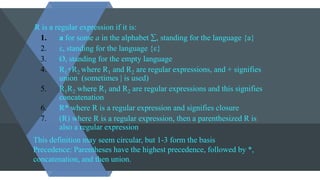This document provides an overview of regular expressions including:
1) The definition of regular expressions in terms of basic elements like characters, concatenation, union and closure.
2) Examples of regular expressions and the languages they describe.
3) How finite automata and regular expressions are equivalent by converting between the two representations.
4) The process of state elimination to convert a DFA to a regular expression.
5) How to construct an epsilon NFA from a regular expression to show their equivalence.
6) Algebraic laws that govern operations on regular expressions like commutativity, distribution, and more.


![General Introduction
► Regular expression is an important notation for specifying patterns. Each pattern
matches a set of strings, so regular expressions serve as names for a set of strings.
Programming language tokens can be described by regular languages.[1]](https://image.slidesharecdn.com/regularexpression-201012142307/85/Regular-expression-3-320.jpg)
















![References
[1] Compiler Design - Regular Expressions ,tutorialspoint.
[2] Wikipedia.
[3] Alfred V. Aho, Monica S. Lam, Ravi Sethi, Jeffrey D. Ullman-Compilers -
Principles, Techniques, and Tools-Pearson_Addison Wesley (2006).](https://image.slidesharecdn.com/regularexpression-201012142307/85/Regular-expression-20-320.jpg)
